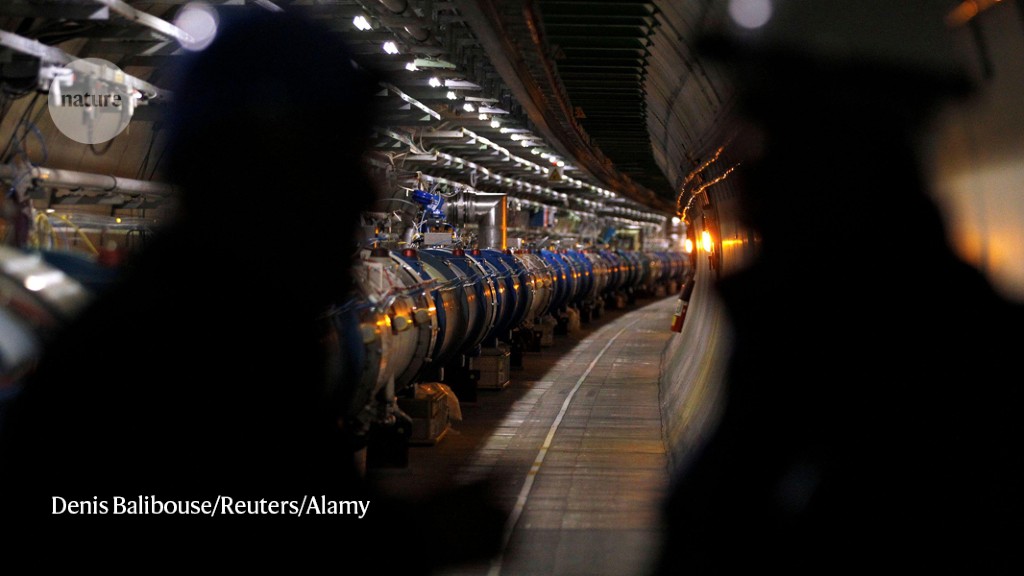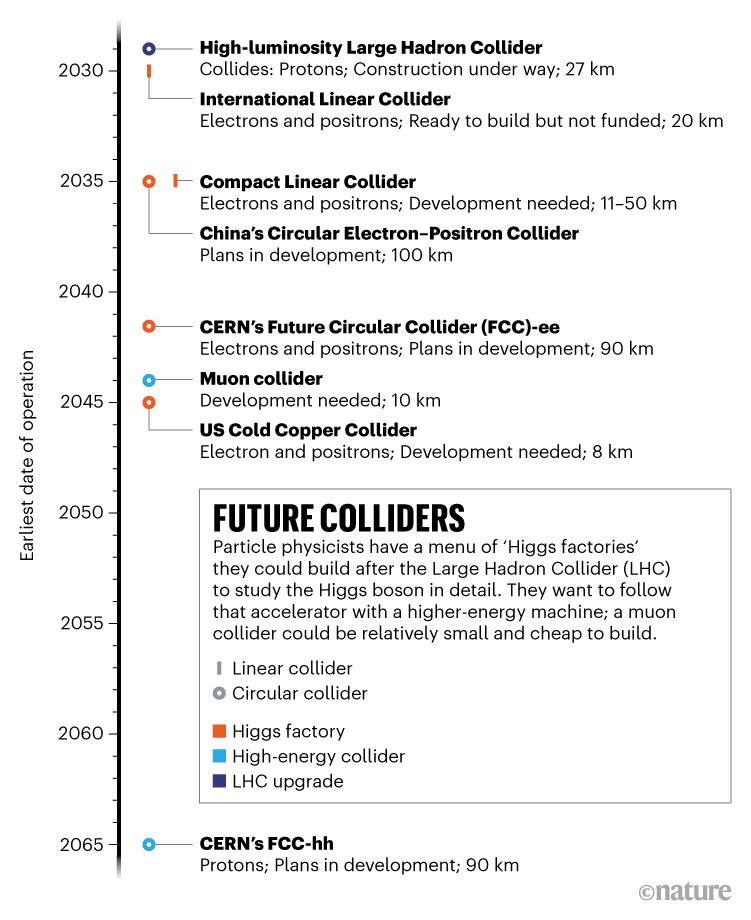Momentum is growing to build a particle collider in the United States that smashes muons — heavier cousins of electrons. The collider would follow the world’s next major accelerator, which is yet to be built, and physicists hope it would discover new elementary particles. Although muons’ short-lived nature makes such a collider technically difficult to build, its major advantage is that it would be smaller and potentially cheaper than competing collider designs. The vision remains distant, into the 2040s at the earliest, but research and development need to begin now, say its advocates.
It’s a “bold and promising vision”, says Karri Di Petrillo, a particle physicist at Fermi National Laboratory (Fermilab) in Batavia, Illinois. Physicists around the world are mulling the feasibility of such a collider, but hosting it in the United States “would be a game changer for my generation of physicists”, she says.
Support among physicists for a muon collider emerged during Snowmass, a major planning exercise by the US particle-physics community that sets out its scientific vision around once a decade. The exercise culminated in a ten-day workshop held in Seattle, Washington, from 17 to 26 July. Organizers will now distil the views of thousands of scientists into a report that describes the field’s major questions and what’s needed to solve them, which will ultimately influence US federal funding. Almost one-third of white papers that physicists contributed to the ‘energy frontier’ section of the exercise were about muon colliders, and excited supporters at the meeting sold T-shirts backing the plans.
Higgs factory
The muon machine would follow construction of a ‘Higgs factory’, a major collider that collaborations in Europe, China and Japan are already vying to build to study the elementary particle known as the Higgs boson in precise detail (see ‘Future colliders’). The Large Hadron Collider (LHC) at CERN, Europe’s particle-physics laboratory near Geneva, Switzerland, discovered the Higgs — which is associated with the field that gives particles mass — in 2012. But it did not discover the other new particles that many physicists expected, and some now believe that might be beyond the machine’s reach.
A Higgs factory would bring together electrons with their antimatter counterparts, positrons, in collisions that are cleaner than the proton–proton smashes in the LHC, allowing for precision studies. In contrast, a muon collider would be a ‘discovery’ machine, trying to find new particles through collisions of unprecedented energy and elucidating the cause of discrepancies found in results from previous experiments.
Muons can be accelerated to higher energies than electrons because they lose less energy as synchrotron radiation. And they have a big advantage over proton collisions. These involve smashes between the particles’ constituent quarks, each of which carries just a fraction of the overall collision energy. Because muons are fundamental particles, every collision involves the particle’s entire energy. This means that a 10-trillion electronvolt (TeV) muon collider, at around 10 kilometres long, could produce particles that have as much energy as those produced by the 100-TeV, 90-kilometre proton machine that CERN is looking to build in the second half of the century.
The muon-collider concept has been around since the 1960s. But only in recent years have viable technologies been developed that might be able to deal with the muon’s quirks, which include the fact that it decays readily, producing bothersome background noise, and is difficult to cajole into forming an intense beam. The excitement among US physicists now is because there is enough time to develop and build the machine to succeed a Higgs factory, and plenty of people to work on it, says Priscilla Cushman, a physicist at the University of Minnesota in Minneapolis.
Whether it would be built in the United States depends on funding and politics, as well as technical feasibility, says Joel Butler, a particle physicist at Fermilab and chair of the Snowmass steering group. CERN is also organizing an international collaboration to study the feasibility of a muon collider. For all the collider options on the table, US physicists must do enough research and development “that when the choices have to be made, they can be made in a good way”, he says.
Enthusiasm for the muon collider chimes with a growing focus on cost and sustainability, says Caterina Vernieri, a particle physicist at Stanford University in California, whois part of a group that pitched a cheaper Higgs-factory design, known as the Cool Copper Collider, as part of the Snowmass process.
Dark matter
Distant colliders were just a small part of the Snowmass agenda. Among their nearer-term plans, physicists highlighted their commitment to a high-intensity upgrade to the LHC from 2026 that will produce more than ten times the data created until that point. They also reiterated their desire to push ahead with a phased construction of a 1,300-kilometre, US-based experiment called DUNE, which is designed to investigate the nature of elusive particles called neutrinos. Some argued for the go-ahead on CMB-S4, a next-generation survey of the cosmic microwave background.
A call that cut across disciplines was to ensure that a wide range of facilities exists to hunt for dark matter. The failure to find a theoretically predicted kind of dark matter known as weakly interacting massive particles (WIMPs) in the past ten years, either at the massive detectors designed to search for them or at the LHC, means that dark matter must be even more exotic than had been thought.
Physicists want to look for much lighter candidates for dark matter, and to reframe their search to consider that it could exist as a whole family of particles, rather than just one, says Suchita Kulkarni, a dark-matter physicist at the University of Graz in Austria, who attended the Snowmass meeting. Finding it will take a few large and sensitive experiments — such as those already looking for WIMPS — and many more small, experimental ones, says Micah Buuck, a physicist at Stanford University.
Funding recommendations
The two-year Snowmass process, to which physicists from around the world submitted 521 papers, was “exhausting, but thrilling”, says Cushman, who is a member of the steering group.
Crunch time will come next year, when the US federal Particle Physics Prioritization Panel, known as P5, will use Snowmass’s conclusions — and budget considerations — to make investment recommendations to funders at the Department of Energy and the National Science Foundation for the next ten years.
Physicists are now working on how best to communicate with funders and the public, says Kulkarni. In the past decade, they haven’t found what many expected — a deviation with the standard model, their best description of particle physics that they know to be incomplete. “The community is making an effort to set a consistent and honest narrative,” Kulkarni says. “We are doing the best we can, and will learn something from it. But discoveries are fickle mistresses, and you never know when you are going to get them.”









More News
Judge dismisses superconductivity physicist’s lawsuit against university
Future of Humanity Institute shuts: what’s next for ‘deep future’ research?
Star Formation Shut Down by Multiphase Gas Outflow in a Galaxy at a Redshift of 2.45 – Nature